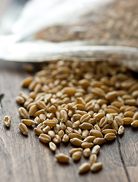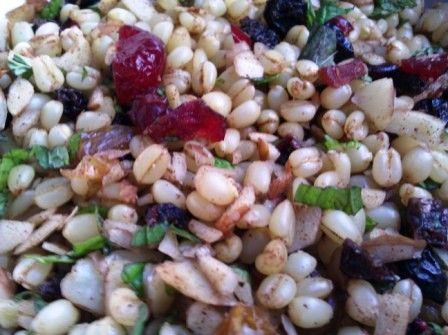Greek “Grain of Tooth”

From pearly-white rice to whole-wheat kernels, grains fortify some of the most popular Greek dishes, including appetizers, main courses, sides, and desserts. This is a Greek kouzina staple that can perform in the background or take a bow center stage. Are you ready to take a bite? …did I hear a “yes”? Lets go then!
Here’s my guide of the most used grains in our kouzina, followed by in-store and online purchase options.

(reezi, pronounced REE-zee)
The five basic types of rice most commonly used in Greek cooking can be found in translucent, pearly whites (similar in appearance to Arborio) and pale-yellow to brown hues, with sizes ranging from medium to long grain.
Glassé (γλασέ, ghlah-SEH, meaning glossy): white medium grain. Best for soups like magiritsa (Pascha/Easter lamb soup) and desserts.
Carolina (καρολίνα, kah-roh-LEE-nah): white medium to long grain. Best for stuffings like dolmadakia (stuffed grape leaves), risotto, and desserts like rizogalo (rice pudding).
Nychaki (νυχάκι, nee-HAH-kee, meaning little fingernail): white long grain. Best for pilafs like spanakorizo (rice with spinach) and salads.
Kitrino (κίρτρινο, KEE-tree-noh, meaning yellow): parboiled (converted) white long-grain rice that has turned a pale yellow after processing. Best for gemista (stuffed foods) like stuffed tomatoes and peppers, pilaf, and rice side dishes.
Kastano (καστανό, kah-stah-NOH, meaning chestnut colored): brown rice. Can used as a substitute for white or yellow rice in many recipes to add healthy fiber to a meal.

(pronounced poo-RYOO-ree / plee-YOO-ree)
Bulgur wheat. Interchangeable with kritharaki, trahana, or kofto in a number of dishes, pourgouri makes soups, salads (above), and side dishes heartier. It can also be cooked alone and served with yogurt.
Pligouri Salata (πλιγούρι σαλάτα, pronounced plee-YOO-ree sah-LAH-tah), Bulgar Salad, is a toss of bulgur, herbs, cucumber, and tomato, which make it as visually appetizing as it is delicious.

(pronounced FEE-rohn)
The whole berry of the wheat grain is used to make salads but it’s best known as the main ingredient in koliva, the decorated dish prepared and offered at Greek memorials. The memorial service for departed loved ones is customarily held immediately after Sunday liturgy, with the koliva placed on a table in front of the alter. The service remembers the souls of those who have passed, during which time everyone prays for their eternal memory and resurrection.
Why farro?
When a wheat seed is planted (buried) in the soil, it eventually emerges as a new plant. In the Greek Orthodox faith, one must die and be buried in order to be resurrected. The wheat in the koliva symbolizes this cycle of eternal life, emphasizing rebirth and regeneration. This ancient custom was derived from Jesus Christ when he spoke about the Resurrection: "Unless the grain of wheat falls into the earth and dies, it remains alone, but if it dies it bears much fruit." (John 12:24)
(pronounced KOH-lee-vah)
Koliva is basically made up of boiled whole-wheat berries, raisins, pomegranate seeds (for fertility/rebirth), walnuts, sesame seeds, parsley, and sugar. This mixture is mounded on a plate and completely covered with powdered sugar, then decorated with nonpareils and Jordan almonds (koufeta), making the sign of a cross and often the initials of the person the service is being held for. After the conclusion of church services, the koliva are offered to everyone during coffee hour. Because they have been blessed, any leftover koliva can not be thrown away so it’s customary to toss them onto grassy areas for animals and birds to feed on.
Got Greek Grains?
If you’re in the New York City area, you can find these Greek grains (and more) at the following markets (some items are available on their websites):
Titan Foods
25-56 31st Street
LIC, N.Y, 11102
718-626-7771
Mediterranean Foods (2 locations)
22-78 35th Street
Astoria, NY 11105
718-728-0266
30-12 34th Street
Astoria, NY 11103
718-728-6166
If you don’t live near these markets but have a Greek Orthodox Church nearby, chances are they know of a Greek/Mediterranean shop in the area.
Online shopping is the next best thing (or maybe the first). Here’s where you can find Greek grains, as well as other foods and items:
Recipiada
Parthenon Foods (bulgur)
igourmet.com (farro)
I hope you enjoyed Grain Kouzina. Many of these grains will be featured in recipes in our upcoming cookbook! Stay tuned for more uniquely Greek and Karpathian foods that you can add to your kouzina pantry.
Sign up for our e-newsletter (if you haven’t already) and stay connected on social media for cooking tips and recipes, as well as for all Kukla's Kouzina updates and news.
Thanks for following us and we’ll see you next Monday.
Until then~
Kali orexi! Good appetite!
Kelly
Web design by Kelly Salonica Staikopoulos




























